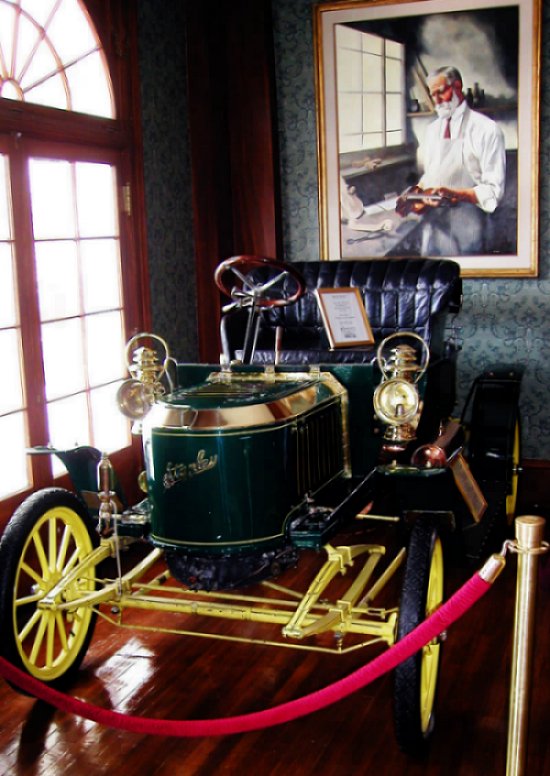Freelan and Francis
Today, the Stanleys and their Steamer. The University of Houston's College of Engineering presents this series about the machines that make our civilization run, and the people whose ingenuity created them.
When I spoke recently in Colorado, my wife and I drove the Rocky Mountain Peak-to-Peak Highway.

At lunchtime we reached the town of Estes Park, where we found a grand old hotel on a hill, dominating the view. We tried it, and the food was fine. But the greater treat was out in the lobby. There we found a 1906 Stanley Steamer. This, it turns out, was the Stanley Hotel! So let us see how it, and that venerable automobile, got there.
Freelan Stanley and his twin brother Francis were born in Maine in 1847. By the time they were fifty, Freelan had been a serious artist and had marketed a line of drafting instruments. Both were amateur violin-makers. Francis had invented the airbrush. Together, they'd developed and marketed dry photographic plates.
Then they grew interested in making automobiles; but how to power such a machine? When Benz made the first commercial automobiles, he used internal combustion engines. Stanley biographer James Pickering tells how the Stanleys came to choose steam. Francis had experience with steam engines; other than that, they began carmaking from scratch. Yet they built an automobile in 1897.
A photo shows the two bearded brothers in their first automobile. They look like they'd stepped off an old Smith Brothers' cough drop box. Those cars were a great success. Within two years, Freelan and his wife were able to motor up New Hampshire's mile-high Mount Washington in one. But by then they'd sold the business to a company now selling them under the name Locomobile.
A year later, they bought the business back for a mere $20,000 and began making the remarkably robust Stanley Steamers. In 1906 and 1907 they set land speed records of 128, and over 150, miles an hour. Airplanes would fly no faster until well after WW-I.
Now the Stanleys sold their Dry Plate Company to Eastman Kodak, which made millions off it. George Eastman also fell in love with the Stanleys' new cars. "If the electric [automobile] is a 'peach'," he wrote, "then the Stanley is a 'peacherina'."
But then Freelan Stanley, who suffered from tuberculosis, had found his way to the small town of Estes Park. In 1909 he built that great hotel on the hillside and entered into a huge array of local enterprises. He lobbied for the creation of Rocky Mountain National Park. He worked on the development of electric power and other utilities in the region.
He also returned to the love of violins he and his brother had shared. At 77, out of automobile-building, with Francis no longer living, Freelan set out to find means for mass-producing Stradivarius-quality violins. Naturally he failed.
But then, it'd always been clear to the Stanleys that challenges were far more rewarding than anything as small as mere success. And that is why you see, hanging there above that Stanley Steamer in the hotel lobby, an oil painting of the aging Freelan lovingly cradling one of his own violins.
I'm John Lienhard, at the University of Houston, where we're interested in the way inventive minds work.
(Theme music)
J.H. Pickering, Mr. Stanley of Estes Park. Estes Park, CO: Stanley Museum, Inc., 2000. I am most grateful to Jim Pickering, UH English Department, for additional counsel.
Dr. Pickering also adds this very interesting footnote: "Incidentally, Stephen King came to the Stanley hotel because it had been built by a fellow Maine-ite. The hotel inspired The Shining, and a graveyard for pets of former owners down the hill, Pet Sematary."

(Photo by John Lienhard)